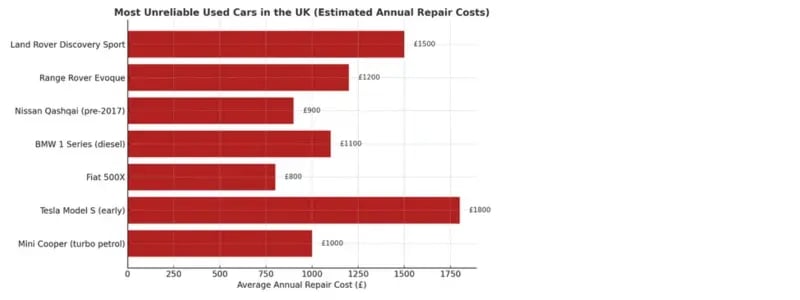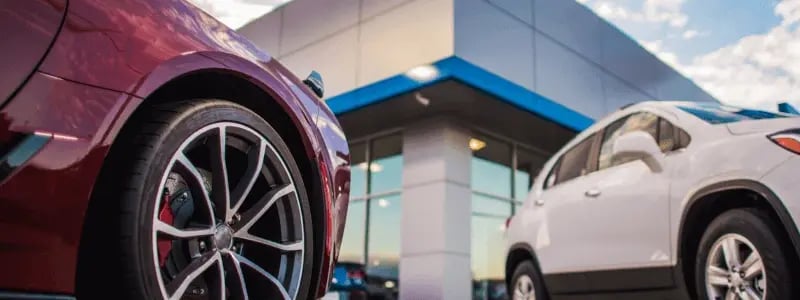Why Reliability Matters In Used Car Sales
by Amy Roberts on Oct 3, 2025 2:45:19 PM
Reliability doesn’t just influence customer satisfaction; it directly impacts finance penetration and customer retention.
According to a recent survey by What Car of 30,000 UK drivers, owners of the most unreliable models reported repair bills running into thousands of pounds within a few years of purchase. That financial pain can sour a customer’s relationship with both the car and the dealer.
Cars with poor reliability scores are more likely to end up with negative equity, as depreciation accelerates when demand drops. That has a knock-on effect for finance customers who may struggle to settle or refinance later.
For brokers and dealerships, the lesson is simple: choosing what not to stock can be just as valuable as finding the right inventory.

The UK’s Most Reliable Used Cars
Source: What Car? October 2025, reliability rating after dash
- Hyundai i10 (2020-present) – 100.0%
- Hyundai Santa Fe (2018-2024) – 100.0%
- Kia EV3 (2024-present) – 100.0%
- Toyota GR Yaris (2020-present) – 100.0%
- Toyota Aygo X (2021-present) – 99.7%
- Vauxhall Grandland petrol (2024-present) – 99.6%
- Toyota RAV4 (2019-present) – 99.2%
- Mini Hatchback (2014-2024) – 99.1%
- Volkswagen T-Roc (2018-2025) – 99.0%
- Porsche Macan (2014-present) – 99.0%

The UK’s Least Reliable Used Cars
While rankings vary slightly depending on the survey, the same names appear time and again. Here are some of the least reliable used cars in the UK based on owner reports:
- Land Rover Discovery Sport
- Consistently ranked near the bottom in reliability studies.
- Owners report frequent electrical issues and gearbox problems.
- Repair costs can average over £1,200 per incident, making it an expensive risk.
- Range Rover Evoque
- Stylish and popular but plagued by electrical and suspension faults.
- High repair frequency means more warranty claims for dealers.
- Nissan Qashqai (older models, pre-2017)
- The UK’s former best-seller appears on many “least reliable” lists.
- Issues with batteries, emissions systems, and suspension are common.
- BMW 1 Series (diesel variants)
- Owners report timing chain and turbocharger failures.
- Diesel particulate filter (DPF) problems are frequent in urban driving.
- Fiat 500X
- Known for niggling faults, particularly with electrics and infotainment systems.
- Although cheap to buy, repeated small faults undermine long-term satisfaction.
- Tesla Model S (early models)
- EVs aren’t immune, older Teslas are cited for battery degradation and software glitches.
- Repairs can be lengthy and expensive due to limited parts and specialist servicing.
- Mini Cooper (turbo petrol models)
- Attractive to younger buyers, but engine and gearbox reliability is a recurring complaint.
.webp?width=800&height=300&name=Car-Finance-Money-4%20(1).webp)
The Cost Of Unreliability
Data shows that drivers of the least reliable cars face annual repair bills averaging £700–£1,500, with some owners hit much harder depending on fault type.
- One survey found that over 40% of Discovery Sport owners reported at least one significant repair within the first three years of ownership.
- Tesla Model S drivers reported repair costs of £1,800 on average once the vehicle was out of warranty.
For customers financing these cars, the extra maintenance costs can push monthly budgets beyond affordability, leading to increased defaults or settlement requests.


What This Means For Dealers And Brokers
- Stock smarter: Cars with poor reliability reputations may be harder to finance competitively, as lenders account for depreciation and higher risk of voluntary terminations.
- Sell transparently: If you do stock these models, full disclosure and warranty options are vital to protecting your reputation and your customers.
- Focus on finance education: Customers drawn in by low upfront costs should be made aware of potential long-term expenses. Pairing a finance deal with a service plan or extended warranty can soften the blow.
.webp?width=800&height=300&name=Helpful%20Tips%20Post%20It%20Note%20(1).webp)
Tips To Minimise Risk When Selling “Unreliable” Models
- Bundle finance with protection
Pair PCP or HP with GAP insurance, warranty cover, or servicing plans. Customers see the safety net, and dealers add margin. - Use reliability as part of the sales script
Flip the narrative. Acknowledge a model’s quirks but position warranties or approved-used checks as the solution. - Know when to say no
If a model consistently causes complaints, be selective. It may be better to walk away than risk reputational damage. - Keep up with market data
Reliability perceptions shift. For example, newer versions of previously unreliable models often improve. Always track the latest owner surveys and Auto Trader data.

Not Every Car On Your Forecourt Will Be A Dream To Own
Some models have reputations that precede them, and ignoring that reality can damage both trust and margins.
By being selective, transparent and pairing finance with smart protection products, dealers and brokers can still turn risk into opportunity, even with cars that don’t top the reliability charts.
👉 At Marsh Finance, we help dealers and brokers de-risk their finance offerings with flexible PCP and HP products (including our unique non-prime PCP), alongside guidance on Consumer Duty compliance and customer outcome monitoring.
Partner with Marsh today and turn more stock, even the tricky ones, into profitable, sustainable finance deals.
- November 2025 (2)
- October 2025 (12)
- September 2025 (8)
- August 2025 (13)
- July 2025 (25)
- June 2025 (17)
- May 2025 (10)
- April 2025 (5)
- March 2025 (6)
- February 2025 (4)
- January 2025 (4)
- December 2024 (10)
- November 2024 (14)
- October 2024 (12)
- September 2024 (25)
- August 2024 (74)
- February 2024 (1)
- May 2023 (2)
- March 2023 (1)
- February 2023 (1)
- December 2022 (1)
- October 2022 (2)
- August 2022 (1)